- Calendar
- Online Ticket Sales
- Access
- JA
- EN
Reopening Celebration III
Art revisited, beauty revealed
Six storied exchanges
December 16, 2020 to February 28, 2021
Hours have been changed.
*There will be an exhibition change during the course of exhibition
*Download the list of changes in works on display
*Photography is permitted at this exhibition.
The list of changes in worksPDF
Story 1 The Ko-Imari Porcelains that Captivated Europe
Full-scale export of Ko-Imari ware is thought to have begun in the latter half of the 17th century, shipping from the port of Nagasaki. The impetus for this dates back to the beginning of the 17th century. European rulers and aristocrats were fascinated by the Chinese porcelains arriving in Europe on Portuguese and Dutch ships. But then the political upheaval of the shift from the Ming to the Qing dynasties led to a temporary yet drastic reduction in Chinese porcelain exports. This led to the export of Ko-Imari ware as their replacement.
The passionate European focus on Asia became the motive force behind the export Ko-Imari aesthetic. Story 1 introduces the Ko-Imari ware produced in Arita that brought together vessel types and motifs from around the world, particularly as seen in the vibrant Kakiemon and Kinrande style wares.
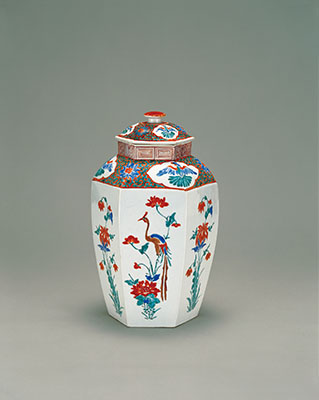
Edo period, 17th century, Suntory Museum of Art
【On display throughout the exhibition period】
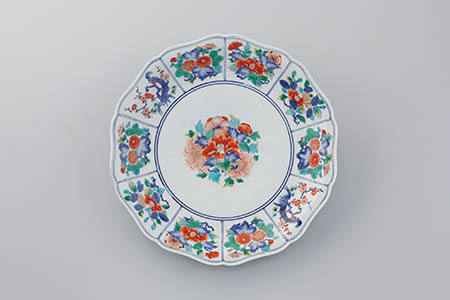
Edo period, 17th–18th centuries, Suntory Museum of Art
【On display throughout the exhibition period】
Story 2 Nabeshima Ware: Ceramics Honed by the Shogunal Gift Presentation System
During the rule of the third Tokugawa shogun, Iemitsu, the Saga domain developed Nabeshima ware for use as domain gifts to the Tokugawa shogunal family. At first the official Nabeshima kiln was located in Arita, but then moved to Okawachiyama (both in present-day Saga prefecture). The official kiln was in use for more than 200 years. The potters at this kiln bore the heavy responsibility of annually producing thousands of consistently high-quality porcelain wares for presentation usage. They also had to constantly strive for innovative and unusual designs on their wares. As they received these ever-stricter demands from their domain lords, the potters developed an all the more refined and elegant aesthetic in their works.
Nabeshima ware was the result of combining Hizen porcelain techniques with an elegance suitable for presentation use. Story 2 provides a fascinating look at the designs adorning round Nabeshima ware dishes and how they reveal the sensibilities, enthusiasms, and pride of the potters who created them.
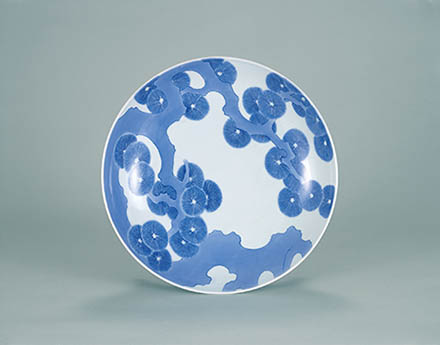
Edo period, 17th–18th centuries, Suntory Museum of Art
【On display throughout the exhibition period】
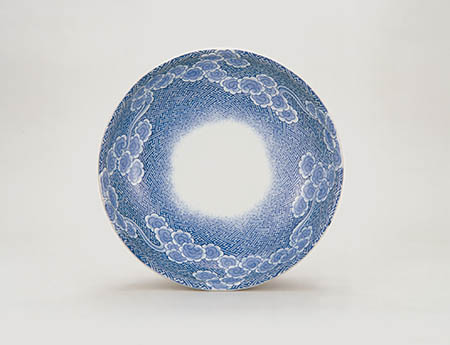
Edo period, 17th–18th centuries, Suntory Museum of Art
【On display throughout the exhibition period】
Story 3 Bingata: The Ryūkyūs' East Asian Culture-Infused Textiles
The Ryūkyū Kingdom flourished from the 15th through the 19th centuries, developing its own unique arts as it conducted sea trade linking China, Japan and Southeast Asia. Bingata stencil dyed textiles were one such art form that was influenced by its surrounding culture and reflected the vivacious lives of the kingdom's people. Vivid colors and diverse motifs reverberate across the surfaces of these textiles that have come to symbolize Okinawa and they continue to fascinate many today.
Story 3 presents fragments of Bingata garments which convey the lovely art of the Ryūkyū Kingdom along with the important stencils which created Bingata forms. Stencils were the tools used to dye the cloth and they reveal the superb craftsmanship of their producers. Please enjoy this colorful realm of Bingata fragments and stencils, all created from the melding of diverse cultures.
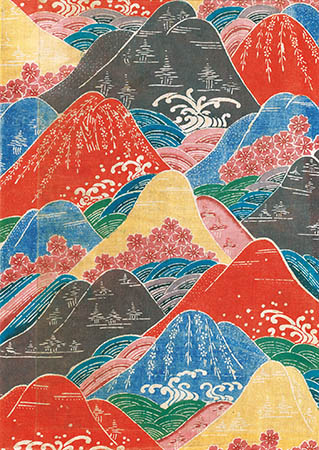
19th century, Ryūkyū Kingdom, Suntory Museum of Art
【On display between Dec. 16 and Jan. 18】
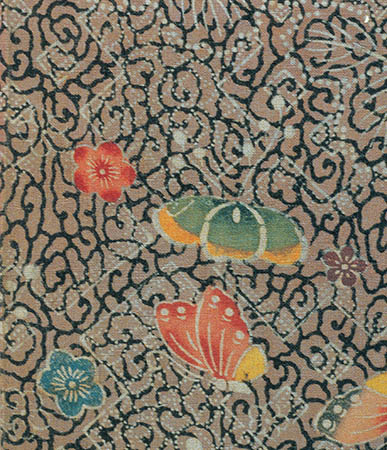
19th century, Ryūkyū Kingdom, Suntory Museum of Art
【On display between Dec. 16 and Jan. 18】
Story 4 Japanese Glass That Arose from Longings for the West
Around the middle of the 16th century Portuguese and Spanish ships began to bring European glassworks, both practical and richly decorative, to Japan. The longing for these glassworks led Japan to begin its own production of glassware from around the mid 17th century. The Edo period names given to glass, biidoro and giyaman, both derive from Portuguese words, another indication of this fascination with European glass.
The biidoro and giyaman works that flourished in the Edo period were not simply copies of European glass, in them we can discern characteristic Japanese material, form and design elements. We hope you will enjoy this display of the new form of glass, melding Japanese aesthetics with a Western art form, brought about by this love of European glass.
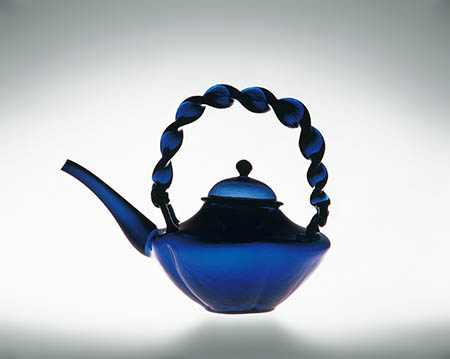
Edo period, 18th century, Suntory Museum of Art
【On display throughout the exhibition period】
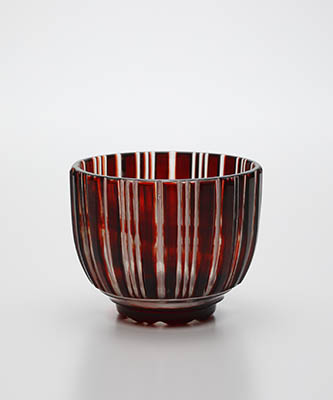
Edo period, mid 19th century, Suntory Museum of Art
【On display throughout the exhibition period】
Story 5 Edo and Meiji Ukiyo-e: Bridging the Cultures of East and West
Ukiyo-e prints, an art form created as part of popular culture, sensitively depicted the "now" of Edo trends and fascinated people from all classes of society. Polychrome woodblock printing was produced by a team focused on the publisher and including the artist, block carver and block printer. This art form representative of Edo culture came to be known as nishiki-e, literally brocade pictures. From an early period these artists incorporated western perspectival methods and other forms of western expression in their prints.
Late Edo period Yokohama prints depicted the Western customs of the newly opened port town of Yokohama, while the Meiji period saw the creation of kaika-e, new culture prints depicting the modernization of the newly renamed capital of Tokyo and its changing appearance. Elements of Western culture fully arrived in Japan during the Meiji period, and artists such as Kobayashi Kiyochika developed new types of expression that wedded these new cultural forms with traditional elements.
This section presents the development of Japanese print art that linked Japanese and Western culture, from traditional Edo period ukiyo-e to the Yokohama prints of the late Edo period, kaika-e prints of the early Meiji and works by Kobayashi Kiyochika and other Meiji period artists.
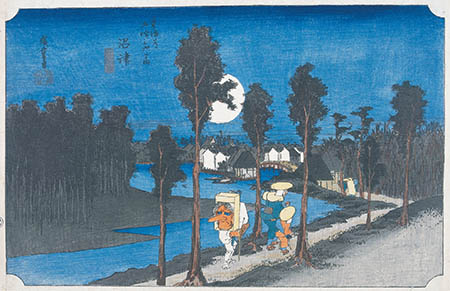
Utagawa Hiroshige, Ōban, polychrome woodblock print,
Edo period, ca. 1833 (Tenpō 4), Suntory Museum of Art
【On display between Dec. 16 and Jan. 18】
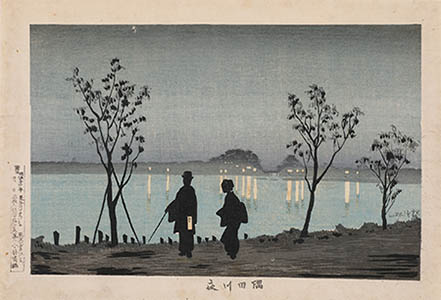
Kobayashi Kiyochika, Ōban, polychrome woodblock print,
1881 (Meiji 14), Suntory Museum of Art
【On display between Dec. 16 and Jan. 18】
Story 6 How Gallé Transformed Foreign Culture Through Unique Expression
The Art Nouveau style, which flourished primarily in European cities from the latter half of the 19th century through the beginning of the 20th century, brought a high degree of artistry to all elements of life, not just to painting and sculpture. Charles Martin Emile Gallé (1846-1904) was one of the leading figures in the Art Nouveau movement, working from his furniture, glass and ceramics manufacturing company in the old city of Nancy, located in the Lorraine district in eastern France.
The works that Gallé created over the approximately 40 years from the 1860s through 1904 accorded with the world exposition era. From a young age Gallé was exposed to Japanese art and other artifacts from around the world at the world expositions being held. He then took the essence of those elements and linked them to the traditions of his own country to create an all the more refined, distinctive expression. In Story 6, we focus on the Gallé glass works in the Suntory Museum of Art collection that are closely linked to Japanese art, including the debut appearance of a work acquired in 2019.
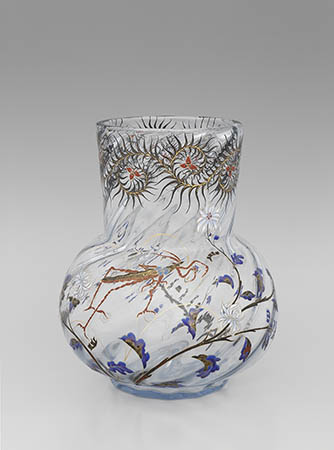
Emile Gallé, ca. 1878, Suntory Museum of Art
【On display throughout the exhibition period】
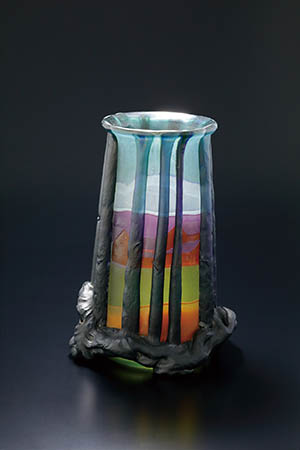
Emile Gallé, ca. 1900, Suntory Museum of Art
【On display throughout the exhibition period】
*Unauthorized reproduction or use of texts or images from this site is prohibited.
2024 January
- Exhibition
- Closed
- Tea Ceremony
- Mon
- Tue
- Wed
- Thu
- Fri
- Sat
- Sun
- 1
- 2
- 3
- 4
- 5
- 6
- 7
- 8
- 9
- 10
- 11
- 12
- 13
- 14
- 15
- 16
- 17
- 18
- 19
- 20
- 21
- 22
- 23
- 24
- 25
- 26
- 27
- 28
- 29
- 30
- 31
2024 February
- Exhibition
- Closed
- Tea Ceremony
- Mon
- Tue
- Wed
- Thu
- Fri
- Sat
- Sun
- 1
- 2
- 3
- 4
- 5
- 6
- 7
- 8
- 9
- 10
- 11
- 12
- 13
- 14
- 15
- 16
- 17
- 18
- 19
- 20
- 21
- 22
- 23
- 24
- 25
- 26
- 27
- 28
- 29
2024 March
- Exhibition
- Closed
- Tea Ceremony
- Mon
- Tue
- Wed
- Thu
- Fri
- Sat
- Sun
- 1
- 2
- 3
- 4
- 5
- 6
- 7
- 8
- 9
- 10
- 11
- 12
- 13
- 14
- 15
- 16
- 17
- 18
- 19
- 20
- 21
- 22
- 23
- 24
- 25
- 26
- 27
- 28
- 29
- 30
- 31
2024 April
- Exhibition
- Closed
- Tea Ceremony
- Mon
- Tue
- Wed
- Thu
- Fri
- Sat
- Sun
- 1
- 2
- 3
- 4
- 5
- 6
- 7
- 8
- 9
- 10
- 11
- 12
- 13
- 14
- 15
- 16
- 17
- 18
- 19
- 20
- 21
- 22
- 23
- 24
- 25
- 26
- 27
- 28
- 29
- 30
2024 May
- Exhibition
- Closed
- Tea Ceremony
- Mon
- Tue
- Wed
- Thu
- Fri
- Sat
- Sun
- 1
- 2
- 3
- 4
- 5
- 6
- 7
- 8
- 9
- 10
- 11
- 12
- 13
- 14
- 15
- 16
- 17
- 18
- 19
- 20
- 21
- 22
- 23
- 24
- 25
- 26
- 27
- 28
- 29
- 30
- 31
2024 June
- Exhibition
- Closed
- Tea Ceremony
- Mon
- Tue
- Wed
- Thu
- Fri
- Sat
- Sun
- 1
- 2
- 3
- 4
- 5
- 6
- 7
- 8
- 9
- 10
- 11
- 12
- 13
- 14
- 15
- 16
- 17
- 18
- 19
- 20
- 21
- 22
- 23
- 24
- 25
- 26
- 27
- 28
- 29
- 30
2024 July
- Exhibition
- Closed
- Tea Ceremony
- Mon
- Tue
- Wed
- Thu
- Fri
- Sat
- Sun
- 1
- 2
- 3
- 4
- 5
- 6
- 7
- 8
- 9
- 10
- 11
- 12
- 13
- 14
- 15
- 16
- 17
- 18
- 19
- 20
- 21
- 22
- 23
- 24
- 25
- 26
- 27
- 28
- 29
- 30
- 31
2024 August
- Exhibition
- Closed
- Tea Ceremony
- Mon
- Tue
- Wed
- Thu
- Fri
- Sat
- Sun
- 1
- 2
- 3
- 4
- 5
- 6
- 7
- 8
- 9
- 10
- 11
- 12
- 13
- 14
- 15
- 16
- 17
- 18
- 19
- 20
- 21
- 22
- 23
- 24
- 25
- 26
- 27
- 28
- 29
- 30
- 31
2024 September
- Exhibition
- Closed
- Tea Ceremony
- Mon
- Tue
- Wed
- Thu
- Fri
- Sat
- Sun
- 1
- 2
- 3
- 4
- 5
- 6
- 7
- 8
- 9
- 10
- 11
- 12
- 13
- 14
- 15
- 16
- 17
- 18
- 19
- 20
- 21
- 22
- 23
- 24
- 25
- 26
- 27
- 28
- 29
- 30
2024 October
- Exhibition
- Closed
- Tea Ceremony
- Mon
- Tue
- Wed
- Thu
- Fri
- Sat
- Sun
- 1
- 2
- 3
- 4
- 5
- 6
- 7
- 8
- 9
- 10
- 11
- 12
- 13
- 14
- 15
- 16
- 17
- 18
- 19
- 20
- 21
- 22
- 23
- 24
- 25
- 26
- 27
- 28
- 29
- 30
- 31
2024 November
- Exhibition
- Closed
- Tea Ceremony
- Mon
- Tue
- Wed
- Thu
- Fri
- Sat
- Sun
- 1
- 2
- 3
- 4
- 5
- 6
- 7
- 8
- 9
- 10
- 11
- 12
- 13
- 14
- 15
- 16
- 17
- 18
- 19
- 20
- 21
- 22
- 23
- 24
- 25
- 26
- 27
- 28
- 29
- 30
2024 December
- Exhibition
- Closed
- Tea Ceremony
- Mon
- Tue
- Wed
- Thu
- Fri
- Sat
- Sun
- 1
- 2
- 3
- 4
- 5
- 6
- 7
- 8
- 9
- 10
- 11
- 12
- 13
- 14
- 15
- 16
- 17
- 18
- 19
- 20
- 21
- 22
- 23
- 24
- 25
- 26
- 27
- 28
- 29
- 30
- 31
2025 January
- Exhibition
- Closed
- Tea Ceremony
- Mon
- Tue
- Wed
- Thu
- Fri
- Sat
- Sun
- 1
- 2
- 3
- 4
- 5
- 6
- 7
- 8
- 9
- 10
- 11
- 12
- 13
- 14
- 15
- 16
- 17
- 18
- 19
- 20
- 21
- 22
- 23
- 24
- 25
- 26
- 27
- 28
- 29
- 30
- 31
2025 February
- Exhibition
- Closed
- Tea Ceremony
- Mon
- Tue
- Wed
- Thu
- Fri
- Sat
- Sun
- 1
- 2
- 3
- 4
- 5
- 6
- 7
- 8
- 9
- 10
- 11
- 12
- 13
- 14
- 15
- 16
- 17
- 18
- 19
- 20
- 21
- 22
- 23
- 24
- 25
- 26
- 27
- 28
2025 March
- Exhibition
- Closed
- Tea Ceremony
- Mon
- Tue
- Wed
- Thu
- Fri
- Sat
- Sun
- 1
- 2
- 3
- 4
- 5
- 6
- 7
- 8
- 9
- 10
- 11
- 12
- 13
- 14
- 15
- 16
- 17
- 18
- 19
- 20
- 21
- 22
- 23
- 24
- 25
- 26
- 27
- 28
- 29
- 30
- 31
2025 April
- Exhibition
- Closed
- Tea Ceremony
- Mon
- Tue
- Wed
- Thu
- Fri
- Sat
- Sun
- 1
- 2
- 3
- 4
- 5
- 6
- 7
- 8
- 9
- 10
- 11
- 12
- 13
- 14
- 15
- 16
- 17
- 18
- 19
- 20
- 21
- 22
- 23
- 24
- 25
- 26
- 27
- 28
- 29
- 30
2025 May
- Exhibition
- Closed
- Tea Ceremony
- Mon
- Tue
- Wed
- Thu
- Fri
- Sat
- Sun
- 1
- 2
- 3
- 4
- 5
- 6
- 7
- 8
- 9
- 10
- 11
- 12
- 13
- 14
- 15
- 16
- 17
- 18
- 19
- 20
- 21
- 22
- 23
- 24
- 25
- 26
- 27
- 28
- 29
- 30
- 31
2025 June
- Exhibition
- Closed
- Tea Ceremony
- Mon
- Tue
- Wed
- Thu
- Fri
- Sat
- Sun
- 1
- 2
- 3
- 4
- 5
- 6
- 7
- 8
- 9
- 10
- 11
- 12
- 13
- 14
- 15
- 16
- 17
- 18
- 19
- 20
- 21
- 22
- 23
- 24
- 25
- 26
- 27
- 28
- 29
- 30
2025 July
- Exhibition
- Closed
- Tea Ceremony
- Mon
- Tue
- Wed
- Thu
- Fri
- Sat
- Sun
- 1
- 2
- 3
- 4
- 5
- 6
- 7
- 8
- 9
- 10
- 11
- 12
- 13
- 14
- 15
- 16
- 17
- 18
- 19
- 20
- 21
- 22
- 23
- 24
- 25
- 26
- 27
- 28
- 29
- 30
- 31
2025 August
- Exhibition
- Closed
- Tea Ceremony
- Mon
- Tue
- Wed
- Thu
- Fri
- Sat
- Sun
- 1
- 2
- 3
- 4
- 5
- 6
- 7
- 8
- 9
- 10
- 11
- 12
- 13
- 14
- 15
- 16
- 17
- 18
- 19
- 20
- 21
- 22
- 23
- 24
- 25
- 26
- 27
- 28
- 29
- 30
- 31
2025 September
- Exhibition
- Closed
- Tea Ceremony
- Mon
- Tue
- Wed
- Thu
- Fri
- Sat
- Sun
- 1
- 2
- 3
- 4
- 5
- 6
- 7
- 8
- 9
- 10
- 11
- 12
- 13
- 14
- 15
- 16
- 17
- 18
- 19
- 20
- 21
- 22
- 23
- 24
- 25
- 26
- 27
- 28
- 29
- 30
2025 October
- Exhibition
- Closed
- Tea Ceremony
- Mon
- Tue
- Wed
- Thu
- Fri
- Sat
- Sun
- 1
- 2
- 3
- 4
- 5
- 6
- 7
- 8
- 9
- 10
- 11
- 12
- 13
- 14
- 15
- 16
- 17
- 18
- 19
- 20
- 21
- 22
- 23
- 24
- 25
- 26
- 27
- 28
- 29
- 30
- 31
2025 November
- Exhibition
- Closed
- Tea Ceremony
- Mon
- Tue
- Wed
- Thu
- Fri
- Sat
- Sun
- 1
- 2
- 3
- 4
- 5
- 6
- 7
- 8
- 9
- 10
- 11
- 12
- 13
- 14
- 15
- 16
- 17
- 18
- 19
- 20
- 21
- 22
- 23
- 24
- 25
- 26
- 27
- 28
- 29
- 30
2025 December
- Exhibition
- Closed
- Tea Ceremony
- Mon
- Tue
- Wed
- Thu
- Fri
- Sat
- Sun
- 1
- 2
- 3
- 4
- 5
- 6
- 7
- 8
- 9
- 10
- 11
- 12
- 13
- 14
- 15
- 16
- 17
- 18
- 19
- 20
- 21
- 22
- 23
- 24
- 25
- 26
- 27
- 28
- 29
- 30
- 31
